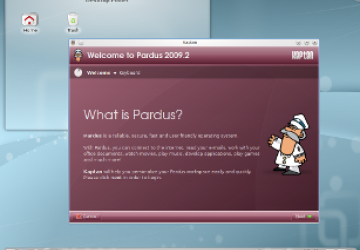Spotlight on Linux: Pardus Linux 2009.2

Pardus Linux is one of those distributions that doesn't get the attention it probably deserves. Pardus makes a wonderful desktop system for those that prefer ease of use. Available as an install image or live CD, it ships with lots of great applications, multimedia support, and browser plugins.
The installer is as easy to use as any in Linux today. It's your basic wizard-type, asking just a few questions before beginning. Users can choose between automatic or manual partitioning, but no package selection is necessary. Upon boot of the new Pardus system, a configuration wizard will appear allowing users to configure their mouse, set up themes and wallpapers, configure the network, use Smolt, and configure update and package preferences.
Pardus ships with a wide selection of KDE applications as well as Firefox 3.6.3, OpenOffice.org 3.2.1.3, and GIMP 2.6.8. Users will also find Amarok, Juk, MPlayer, and TVtime for various media needs. For bloggers, Blogilo and Choqok are included. Other packages can be installed through the Package Manager, which has an interface similar in appearance to openSUSE's YaST software manager. Pardus repositories contain about 3500 packages, so your favorite might just be a few clicks away.
Other amenities include a simple firewall configuration tool for those who connect directly to the Internet from their desktop. Pardus also provides a migration wizard for those who might like to import their settings and files from other systems. For those who are leery to update, Pardus includes a History Manager which will take snapshots of your current system that can be restored should something bad happen.
Pardus hails from Turkey, so at first boot of either image the user will find themselves faced with the Turkish language. But have no fear, F2 brings up the language selector where one can choose English. Pardus is developed by the Scientific & Technological Research Council of Turkey, an advisory office to the Turkish government, which is probably why this distribution feels so professionally done. Original tools and graphics appear throughout giving Pardus a very consistent look and feel.
Advantages include an easy and attractive installer, complete system out of the box, and handy migration and customizing wizards. Disadvantages are harder to find, but perhaps their repositories aren't as fully populated as some other distros. Otherwise, Pardus deserves its place right along side of other greats like Linux Mint, SimplyMepis, or PCLinuxOS.










